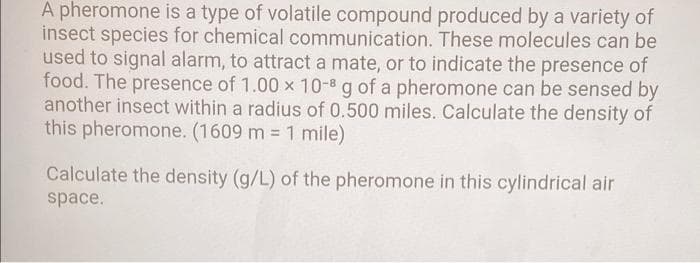A pheromone is a type of volatile compound produced by a variety of insect species for chemical communication. These molecules can be used to signal alarm, to attract a mate, or to indicate the presence of food. The presence of 1.00 x 10-8 g of a pheromone can be sensed by another insect within a radius of 0.500 miles. Calculate the density of this pheromone. (1609 m 1 mile) %3D Calculate the density (g/L) of the pheromone in this cylindrical air space.
A pheromone is a type of volatile compound produced by a variety of insect species for chemical communication. These molecules can be used to signal alarm, to attract a mate, or to indicate the presence of food. The presence of 1.00 x 10-8 g of a pheromone can be sensed by another insect within a radius of 0.500 miles. Calculate the density of this pheromone. (1609 m 1 mile) %3D Calculate the density (g/L) of the pheromone in this cylindrical air space.
Chemistry
10th Edition
ISBN:9781305957404
Author:Steven S. Zumdahl, Susan A. Zumdahl, Donald J. DeCoste
Publisher:Steven S. Zumdahl, Susan A. Zumdahl, Donald J. DeCoste
Chapter1: Chemical Foundations
Section: Chapter Questions
Problem 1RQ: Define and explain the differences between the following terms. a. law and theory b. theory and...
Related questions
Question

Transcribed Image Text:A pheromone is a type of volatile compound produced by a variety of
insect species for chemical communication. These molecules can be
used to signal alarm, to attract a mate, or to indicate the presence of
food. The presence of 1.00 x 10-8 g of a pheromone can be sensed by
another insect within a radius of 0.500 miles. Calculate the density of
this pheromone. (1609 m = 1 mile)
%3D
Calculate the density (g/L) of the pheromone in this cylindrical air
space.
Expert Solution
This question has been solved!
Explore an expertly crafted, step-by-step solution for a thorough understanding of key concepts.
This is a popular solution!
Trending now
This is a popular solution!
Step by step
Solved in 2 steps with 2 images

Knowledge Booster
Learn more about
Need a deep-dive on the concept behind this application? Look no further. Learn more about this topic, chemistry and related others by exploring similar questions and additional content below.Recommended textbooks for you

Chemistry
Chemistry
ISBN:
9781305957404
Author:
Steven S. Zumdahl, Susan A. Zumdahl, Donald J. DeCoste
Publisher:
Cengage Learning

Chemistry
Chemistry
ISBN:
9781259911156
Author:
Raymond Chang Dr., Jason Overby Professor
Publisher:
McGraw-Hill Education

Principles of Instrumental Analysis
Chemistry
ISBN:
9781305577213
Author:
Douglas A. Skoog, F. James Holler, Stanley R. Crouch
Publisher:
Cengage Learning

Chemistry
Chemistry
ISBN:
9781305957404
Author:
Steven S. Zumdahl, Susan A. Zumdahl, Donald J. DeCoste
Publisher:
Cengage Learning

Chemistry
Chemistry
ISBN:
9781259911156
Author:
Raymond Chang Dr., Jason Overby Professor
Publisher:
McGraw-Hill Education

Principles of Instrumental Analysis
Chemistry
ISBN:
9781305577213
Author:
Douglas A. Skoog, F. James Holler, Stanley R. Crouch
Publisher:
Cengage Learning

Organic Chemistry
Chemistry
ISBN:
9780078021558
Author:
Janice Gorzynski Smith Dr.
Publisher:
McGraw-Hill Education

Chemistry: Principles and Reactions
Chemistry
ISBN:
9781305079373
Author:
William L. Masterton, Cecile N. Hurley
Publisher:
Cengage Learning

Elementary Principles of Chemical Processes, Bind…
Chemistry
ISBN:
9781118431221
Author:
Richard M. Felder, Ronald W. Rousseau, Lisa G. Bullard
Publisher:
WILEY